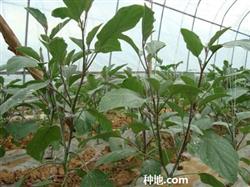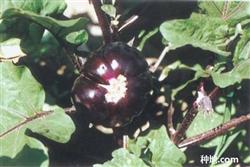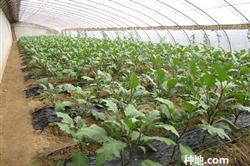How should grafted eggplant be planted?

How should grafted eggplant be planted? Please introduce the eggplant grafting technology is a technique of using wild eggplant as the rootstock to graft eggplant seedlings on the rootstock. The grafted eggplant can grow to 1.5-2m, and the picking period is more than 200 days. In the northern alpine areas, the locally produced eggplant can be eaten in winter, which reduces the production cost. In terms of yield, an average of more than 30 eggplants can be harvested per plant, with a maximum of 40-50 eggplants per plant, and the per unit yield can reach 100-150 t hm'. In the aspect of commodity, grafted eggplant is large, the weight of single fruit is about 400g, and the large one can reach 800-1000g, and the quality is good and the sweetness is increased. The grafting technology of eggplant can increase the economic benefit by about 60, 000 yuan / hm'. In the northern alpine areas, it also solves the problem of production and supply in the same year. The most important level is the strong disease resistance of grafted eggplant. Common eggplant Verticillium wilt, Rhizoctonia solanacearum, bacterial wilt, root-knot filariasis and other soil-borne diseases are very serious and harmful. Generally, 50% of dead seedlings are 70%, and even no harvest is serious. Grafted eggplant fundamentally prevents the occurrence of these soil-borne diseases and reduces the use of pesticides, thus reducing the residues of eggplant pesticides. The following are the main cultivation techniques of grafted eggplant. 1. Eggplant grafted rootstocks and scions are mainly used in the production of rootstocks such as CRP, Tolubam and so on. CRP is a wild Solanaceae plant with many thorns on its stems and leaves. The rootstock is highly resistant to Verticillium wilt and is widely used in production. Tolubam, which comes from Japan, is an ideal rootstock material with high resistance to four kinds of soil-borne diseases or rabbit plague. There is no significant difference in affinity between scions and rootstocks. Scions should be selected according to local eating habits, commerciality and cultivation season. 2. Conventional seedling raising and split seedling raising: Torubam is more difficult to sprout than CRP, but there are three methods of bud destruction. Direct seeding: soak the seeds for 48 hours, disinfect the seedling bed, pour sole water, sow evenly, cover with soil and then cover with film. When the temperature difference between day and night reached 10 ℃, the seedlings emerged in 10-15 days. Incubator temperature change treatment: soak the seeds for 48 hours, put them in a cloth bag, put them in a thermostat, adjust the temperature, 8 hours at 30 ℃, 20 ℃ at 16 hours, repeatedly change the temperature, drop the seeds with clean water once a day, and sprout in 8 days. Hormone treatment: after soaking with gibberellin of 100-200mg concentration per kg water for 24 hours, then soaking in clean water for 24 hours, put it in the incubator or on the Kang head for variable temperature treatment to destroy buds. Generally, buds can sprout in 4-5 days. Sowing: spray the seedling bed with 50% carbendazim 500 times solution, then evenly sow the seeds of the budded rootstocks on the seedbed, cover with plastic film, and remove the mulch after 3-5 days. Scion seedling: scion seedbed, seeds, etc., should be disinfected, lest scion with bacteria, can not achieve the purpose of grafting. The seeds can be soaked in 55 ℃ warm water for 2 hours, or 30m in 0.3% potassium permanganate. The soil can be disinfected with 100g sulfonated humic acid and 5g Lvshen No.1, and water 30kg is added to make a solution to water the seedling bed thoroughly. Seedling division: when the true leaves of rootstock and scion grow to 2-3 leaves, the rootstock is moved into the nutrition bowl, the scion is moved into the seedling bed, and the scion seedling should be 20 days later than that of rootstock. 3. Grafting technique when the rootstock grows to 6-8 true leaves and the scion grows to 5-7 true leaves, the stem is 3~5mm in diameter and the best grafting time is in Lignification. Split method: cut off the upper part of the rootstock at the height of 4bm, leaving 2-3 true leaves, not too high or too short, otherwise the survival will be affected. The lower end of the scion seedling was removed at the semi-lignified place, that is, where the seedling stem was black-purple and green, and 2 or 3 true leaves were retained, cut into a wedge size equal to the cut of the rootstock, inserted into the incision of the rootstock, aligned and fixed with a grafting clip. Affixing method: cut the rootstock and scion into a 30 °inclination angle and stick them together, the other is the same as the split method. 4. Management of grafted seedlings the survival rate of grafted eggplant seedlings is closely related to the management after grafting. Water the grafted seedlings thoroughly and do not spray them to prevent wound infection. Buckle on the small arch shed, the suitable temperature for wound healing of grafted seedlings is 25-26 ℃ in daytime, 20-22 ℃ at night, humidity above 95%, shading completely in the first 3-4 days after grafting, shading at noon, putting light in the morning and evening, gradually removing the covering as the wound heals, and transferring to routine management after survival. Stubble arrangement: open field cultivation, in the northern region, raising seedlings in mid-late January or early-mid-February, planting in mid-late April or early-mid-May. Protected cultivation, autumn and winter, seedling in June, planting in mid-September. In winter and spring, seedlings were raised in early September and planted in mid-December. Planting: applying farm manure more than 75t / hm' and ridging cultivation. Open field ridge width 50cm, high l5cm, protected ridge width 60cm, ridge high 20cm. The open field density is about 45000 plants / hm', and the protected field planting is 3-38000 plants / hm'. Fifth, field management, ploughing, soil cultivation: ploughing in time after planting and watering the seedlings, watering the second water about 10 days after planting, deep hoeing 5-7cm, cultivating the soil, not burying the interface, and then squatting seedlings. Pruning and erection: remove the side branches in time during the growth of Shuo, and take double-trunk pruning. When the grafted eggplant grows to lm height, it needs to be set up, or rope hangers can be used to insert two rows of 80cm viaducts on both sides of the border to control the tilt of eggplant to both sides so as not to cause ventilation, poor lighting and inconvenient operation. Hormone treatment: dip the flower bud with 50-70 times solution of tomato high yield agent No. 2 plant growth regulator to prevent falling flowers and fruits. Temperature management: eggplant in greenhouse underwent four-stage variable temperature management, 25-30 ℃ in sunny morning, 20: 28 ℃ in the afternoon, 13-20 ℃ in the first midnight, and 10-13 ℃ in the latter midnight. No more than 20 ℃ in cloudy days and 10-13 ℃ at night. Warm up properly when the weather is cold. Water and fertilizer management: after squatting seedlings, when the eggplant in the open field grows to the size of walnut, when the eggplant egg in the protected field is the size of the egg, the squatting seedling ends. Because the grafted eggplant grows luxuriantly, water and fertilizer must keep up. The amount of water for overwintering cultivation in protected areas is not easy, but the soil can not be dry due to lack of water, and the air relative humidity is not more than 80%. After the arrival of spring, the amount of water will be gradually increased. Pest control: due to the high temperature and high humidity in the protected area, eggplant is prone to brown streak. If it occurs, 65% mancozeb 500 times, 75% chlorothalonil 600 times, sprayed every 7-10 days, 3-4 times in a row. Eggplant cotton blight can use 40% ethyl phosphate aluminum 300-400 times, 65% mancozeb 500 times, 75% chlorothalonil 500-800 times. Spray every 7-10 days for 2-3 times. Red spiders can be sprayed with 1000 times of dicofol and 1000 times of dimethoate. Aphids and whitefly can use 30% insect mite smoke agent, divided into 60-75 stacks, dark fire lit fumigation. Click to get more eggplant planting techniques click to get more vegetable planting techniques
- Prev

What causes eggplant stiff fruit?
What causes eggplant stiff fruit? Please introduce eggplant fruit symptoms after fruit expansion stops, the top of the fruit is sunken, the fruit hardens, loses edible value, or reluctantly expands, but the long fruit becomes a round fruit, and the round fruit forms a "black peel fruit" because half of the fruit is not inflated. Most zombie peels.
- Next

Why doesn't eggplant in greenhouse set fruit?
Why doesn't eggplant in greenhouse set fruit? Please introduce the reasons why eggplant does not set fruit in greenhouse: poor environmental conditions, such as insufficient light, continuous low temperature, excessive humidity and the occurrence of some diseases and insect pests; excessive density, low ventilation, malnutrition and so on may cause eggplant not to set fruit. In addition to the proper control in cultivation.
Related
- Where is it suitable to grow horseradish in China? it is expected to see the middle altitude horseradish in Alishan.
- How to prevent tomato virus disease reasonably? (Control methods included)
- Many people like to plant towel gourd on the balcony. What are the main points of this method and management?
- What crops can chili peppers be mixed with?
- Fertilization techniques and matters needing attention in Tomato
- What are the grafting techniques for peach seedlings in spring?
- Harm and control methods of root swelling disease of Chinese cabbage
- What are the pests of sweet potatoes? How to prevent and cure it?
- Symptoms, causes and Control methods of navel Rot in Tomato
- The cause of "Cucumber rotten bibcock" in Farmers' planting Cucumber and its Control Plan

